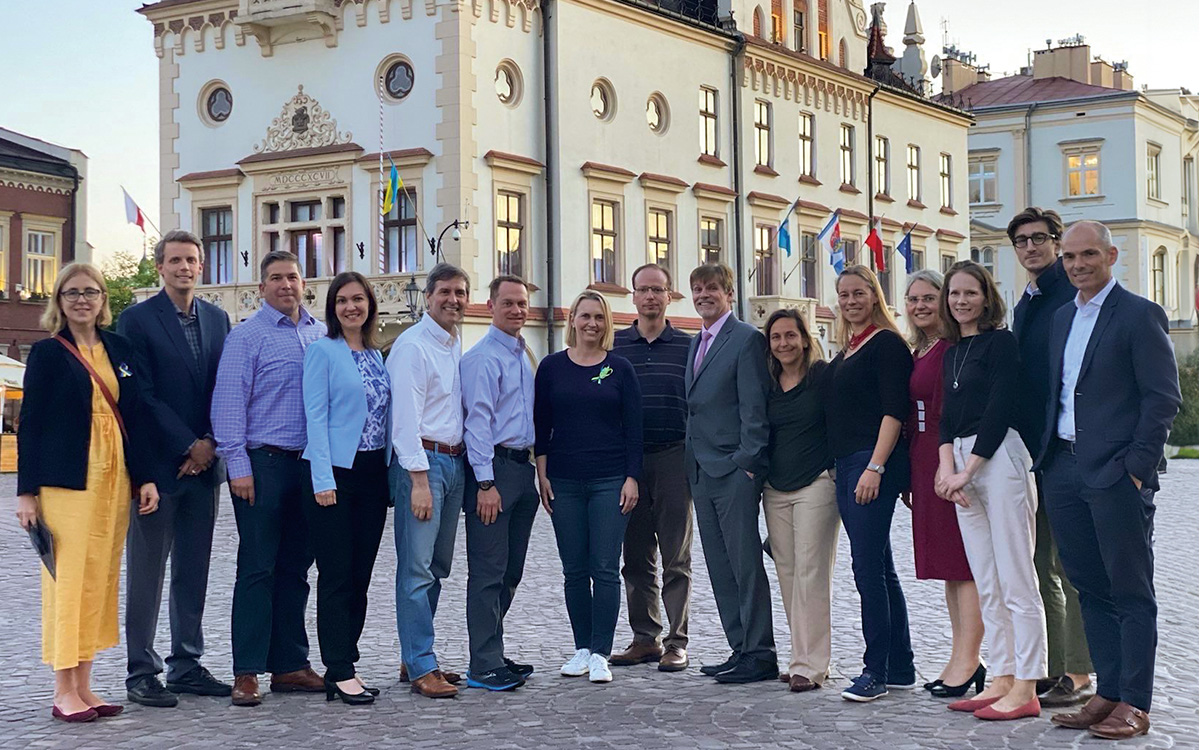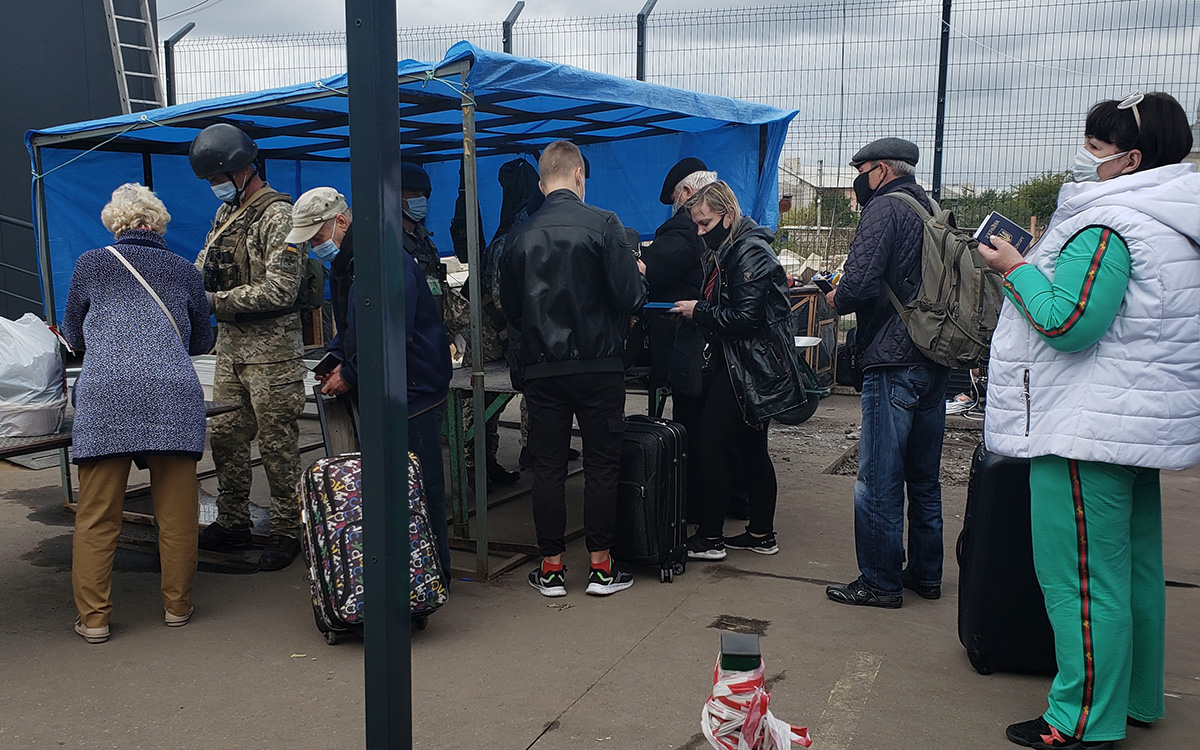15 Minutes That Mattered: Wartime Assistance to Ukraine
The massive U.S. assistance mission to Ukraine began at a roadside council of Embassy Kyiv evacuees in Poland. An FSO who was there tells the story and draws some lessons.
BY DAVID SCHLAEFER

Ambassador Bridget Brink (center) and the Embassy-Kyiv-in-exile team in Rzeszow, Poland, immediately before returning to Ukraine in June 2022. The author is seventh from right.
U.S. Embassy Kyiv
You never know when it’s going to happen, when those 15 minutes are going to come. It’s usually unexpected—a midnight phone call, a shrieking klaxon siren, or a hastily arranged Emergency Action Committee meeting that changes your life and career trajectory. You can’t be sure of timing, location, or impact; but for most members of the Foreign Service, there will come a moment once or twice in your career when a sharp line neatly divides everything that came before and everything that came afterward.
That inflection point came for me in February 2022. As the senior assistance coordinator at U.S. Embassy Kyiv, I had been managing an annual Ukraine appropriation of just over a half billion dollars. Now, with Russia’s invasion imminent and the embassy evacuated, I found myself standing on the side of the road just across the Polish border with about 10 colleagues. Just that morning, we had received hazy instructions from Washington to flee Ukraine and use ordered departure to return immediately to the States.
There we were, a ragtag group with phones that didn’t work, near empty gas tanks in our stuffed-to-the-brim POVs, and no clear idea of what to do. During the next 15 minutes, as the first wave of refugees pushed past us, we made a collective decision to ignore our sketchy instructions from D.C. and stay the course, finding some way to continue to support Ukraine at the most critical of times. We wheeled our sputtering cars around, and instead of heading north to Warsaw and flights back to the States, we turned south to Krakow, our nearest consulate.
None of us knew it at the time, but that short roadside war council was the start of the largest U.S. assistance mission in Europe since the Marshall Plan.
Coming Together
A quick call to Principal Officer Patrick Slowinski confirmed that they could accommodate us, and within hours, we were up and running at the consulate in Krakow and in touch with our local staff inside Ukraine. Our chargé and several other colleagues from whom we’d been separated wound up in Rzeszow at the Polish-Ukrainian border. We eventually all reunited and got to work.
Over the coming weeks and months, this small interagency team—from consular, economic, political, and management sections; USAID; the Bureau of International Narcotics and Law Enforcement; and the Justice Department—the remnant of what had been a sprawling mission, worked feverishly to facilitate the flow of emergency assistance into Ukraine.
As the invasion unfolded, every significant assistance delivery was brokered in whole or in part by this team. It meant thousands of pieces of body armor, hundreds of vehicles, tankers full of fuel, precious medical and food supplies, and, of course, security items reaching Ukraine in the nick of time. Lives were saved and Ukrainian resistance immeasurably strengthened. To quote Margaret Meade: “Never doubt that a small group of thoughtful, committed individuals can change the world.”
Over the past two and a half years, our efforts in Ukraine have evolved into an assistance effort not seen since immediately after WWII. I’m always somewhat skeptical about the ability to distill universal lessons from so exceptional a set of circumstances. Another famous quote, this one from Ralph Waldo Emerson, often comes to mind: “A foolish consistency is the hobgoblin of little minds.” But I have to think that somewhere amid the complexity of our assistance efforts are some hard-earned lessons with applicability beyond Ukraine.
One thing is for certain. Our assistance to Ukraine has had a greater impact than any other contemporary large-scale assistance mission. We have made a difference.

The exodus begins: Ukrainians queue for U.S.-provided emergency assistance prior to fleeing the country into Poland as Russia’s forces launch their invasion in February 2022. The U.S. provided food, medicines, clothing, and other forms of humanitarian aid to tens of thousands of Ukrainian refugees in the war’s opening stages.
David Schlaefer
Convening Authority
When thinking about some of the keys to our success, the overarching importance of lateral coordination among stakeholders is an obvious place to start. In Ukraine, we achieved this through a set of sectoral and thematic working groups at post. I had little subject matter expertise in any given area, but as the storm clouds gathered and invasion loomed ever larger, I used the only real authority I had, convening authority, to bring agencies together for discussions. Border issues, cybersecurity, strategic communications, energy, health, Black Sea export issues, and several others provided a solid platform for planning efforts.
We used a variable-aperture method in deliberations, sometimes keeping discussions at the 30,000-foot level, as with larger-scale USAID humanitarian assistance efforts, and sometimes digging into project-level coordination, for example, with cyber, Centers for Disease Control and Prevention (CDC), and President’s Emergency Plan for AIDS Relief (PEPFAR) activities. Most importantly, we employed Ambassador Bridget Brink’s prime directive, a relentless proactivity to inform Washington planning from the field and give senior decision-makers the options they needed to maximize results.
Leveraging reforms is another vital piece of the assistance puzzle. Challenges provide opportunity. From the outset, we approached large-scale assistance provision as an opportunity to help Ukraine improve systemic concerns like anti-corruption, good governance, and strengthened institutional capacity. As the crisis moved from the acute existential phase of early 2022 to a more protracted conflict, we adjusted our reform agenda to include a focus on improving the legal climate and regulatory environment to better attract foreign investment, increase revenue generation, and create the basis for a strong, sustainable recovery. Implementing reform agendas is often like pulling teeth; but in the case of Ukraine, our efforts have proved to be a catalyst for real change and social transformation. We hope this will continue.
The adaptability applied to our reform agenda is really just one aspect of the larger flexibility we strove for throughout the crisis. There’s no shortage of strategic assistance plans, but responding to changing conditions on the ground in real time and making continuous adjustments based on shifting needs and priorities have enabled U.S. assistance to Ukraine to remain effective. USAID, in particular, has been nimble in its constant evaluation and recalibration of activities across the board, and this is nowhere more evident than in the energy sector, where Russian attacks have significantly degraded Ukraine’s generating capacity. USAID, the Department of Energy, and others have replied with agility and continue to do so despite tremendous challenges. Flexibility in planning and willingness to course correct in midstream when circumstances warrant is often easier said than done, but it has been an important part of our success story in Ukraine.
The sheer volume of U.S. assistance to Ukraine since the beginning of Russia’s full-scale invasion—$136 billion, including the last supplemental—creates special challenges and responsibilities regarding monitoring and accountability. Accountability for this money—doing everything we can to ensure that assistance effectively serves its intended purposes—is difficult, but we have prioritized it from the outset. The biggest challenge we face is obvious: Many of these programs and projects are in areas either close to the shifting front lines or subject to continuous pounding from missile attacks. Kinetics and their attendant security concerns amid the biggest conventional conflict since World War II limit our ability to use traditional monitoring in some cases.
We’ve developed, however, a robust system of measures to ensure effective oversight, starting with coordinated, missionwide prioritization of monitoring targets, site visits, expanded end-use monitoring, third-party monitoring mechanisms, remote-monitoring technologies, and embedded advisers. We also have a team of USAID, Defense Department, and State Office of Inspector General (OIG) personnel in-country and integrated into our operational rhythm. I served in Iraq and have done assistance monitoring before, but the mosaic that we’ve developed in Ukraine in response to the inherent challenges is exceptional.
No Guarantees
There are other aspects I could mention. A focus on inclusivity, gender equality, and local partnerships comes to mind. But I think the broad concepts discussed above are crucial and probably replicable in different ways in most crises. Coordinating laterally and nurturing stakeholder buy-in strengthens planning and implementation. Leveraging reforms helps to win the future. Flexibility ensures relevance and effectiveness. And a razor-sharp focus on oversight guarantees fiscal responsibility.
Outcomes are never guaranteed, and there’s no way to know what the endgame in Ukraine will eventually be. But those 15 minutes on the roadside and the commitment of my colleagues moved mountains. Everything we’ve accomplished since stems from that.
When sharing or linking to FSJ articles online, which we welcome and encourage, please be sure to cite the magazine (The Foreign Service Journal) and the month and year of publication. Please check the permissions page for further details.
Read More...
- “Ukraine Reconstruction: Priorities, Institutions, and the Private Sector” by Michael A. Lally, The Foreign Service Journal, October 2022
- “Understanding Ukraine” by William B. Taylor, The Foreign Service Journal, October 2022
- “‘Cybersecurity and Energy Resilience’ project has been launched to protect Ukrainian energy sector,” ISSP, November 2023





